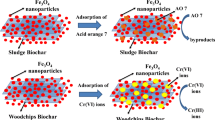Abstract
The surface properties of minerals can be influenced and changed by microbial activities when microorganisms adhere to the mineral surface. The change of mineral surface properties and thus mineral floatability can be used to separate gangues from valuable minerals. This study investigated the Rhodococcus opacus (R. opacus) adsorption behavior on the surfaces of calcite, serpentine, and dolomite by bioadhesive test, contact angle measurements, Zeta potential, Fourier transform infrared spectroscopy (FTIR) spectra, and scanning electron microscopy (SEM). The results showed that R. opacus could be absorbed well onto the surfaces of calcite, serpentine, and dolomite in a few minutes, with adsorption rate up to 96%. The cell adsorption was dependent on the pH value and the most suitable pH is 7.2, whereas no significant influence of temperature on adsorption was found. Increasing pulp density could provide more adsorption sites to R. opacus cells and increase the adsorption rate consequently. The contact angle of three minerals decreased after R. opacus attached, which indicated that the dispersibility of the mineral surface was improved and in favor of being separated. Zeta potential measurements showed that the cell with the charge was opposite to that of minerals on a broad of pH value. The SEM images showed that R. opacus attached very tightly onto the mineral surface, with a large number of small mineral particles gathered around the cell. FTIR spectra showed the presence of polymer groups on the cell wall that could have given a net charge on the mineral surface.









Similar content being viewed by others
References
A. Li, H.-X. Li, Y.-C. Guo, and L. Wang, Metal Mine 6, 109 (2010).
M. Zhang, H.-X. Li, M. Andrade, W. Xuan, and A. Araujo, Miner. Metall. Process. J. (2014).
X. Zheng, P.J. Arps, and R.W. Smith, Int. J. Miner. Process. 62, 159 (2001).
P. Patra and K.A. Natarajan, Miner. Eng. 16, 965 (2003).
P. Patra and K.A. Natarajan, Miner. Process 74, 143 (2004).
P. Patra and K.A. Natarajan, Colloids Surf. B 36, 91 (2004).
A.E.C. Botero, M.L. Torem, and L.M.S. de Mesquita, Miner. Eng. 20, 1026 (2007).
A.E.C. Botero, M.L. Torem, and L.M.S. de Mesquita, Miner. Eng. 21, 83 (2008).
B.Y.M. Bueno, M.L. Torem, F. Molina, and L.M.S. de Mesquita, Miner. Eng. 21, 65 (2008).
Y.-Q. Lu and Z.-H. Deng, Practical Infrared Spectroscopy Analysis (Beijing: Electronic Industry Press, 1989), pp. 27–35.
Acknowledgements
The authors gratefully acknowledge the financial support of the National Science Foundation of PRC for the Research Projects (2013-51234008, 2009-20876014), and the Beijing technical development project (00012132).
Author information
Authors and Affiliations
Corresponding author
Rights and permissions
About this article
Cite this article
Li, H., Zhang, M., Li, C. et al. Bioadsorption Behavior of Rhodococcus Opacus on the Surface of Calcium and Magnesium Minerals. JOM 67, 382–390 (2015). https://doi.org/10.1007/s11837-014-1209-3
Received:
Accepted:
Published:
Issue Date:
DOI: https://doi.org/10.1007/s11837-014-1209-3




